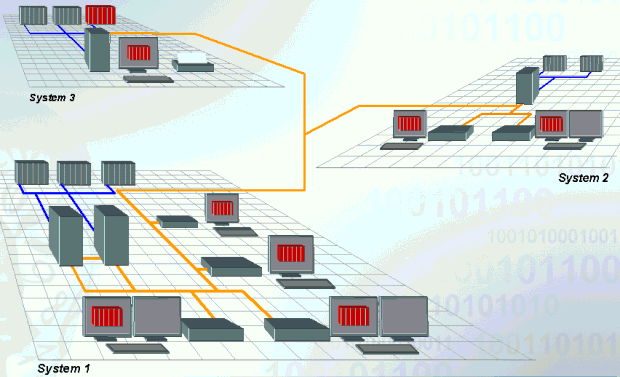Distributed systems
Distributed systems in WinCC OA allow to connect two or more autonomous WinCC OA systems via a network.
Each sub system of a distributed system can be configured either as single-station system or multiple-station system in each case redundant or not redundant. A sub system means in this connection a server on which an Event manager is running on (this means not necessarily a complete project). In a redundant system both redundant running servers are considered as one system.
The distributed systems in WinCC OA are intended for supporting following problems:
- Connecting several stand-alone WinCC OA systems
- Increased performance (increase of the entire performance and number of the DPEs via load sharing on several computers)
- 1 central system and "unoccupied" subsystems
Each system can process and display data (values and alerts) of other systems. You can also access online values, alerts and history of each system by using distributed systems in WinCC OA ("distributed database"). When you access remote DPEs the data points of the sub systems are not copied to the local system. This means that the data points are not multiplied and you can only access the system when a connection to this specific system exists.
The distribution manager (shortly referred to as Dist manager) builds the interface to other systems. Only the Dist manager is responsible for the communication with the configured sub systems. Thus, the Dist manager has to be added to the console and started for the proper functionality of the distributed systems in WinCC OA.
The distributed systems are configured easily when creating a project by using a wizard (see Create a distributed system) or by specifying few entries in the config file of your project (see Configuration file for distributed systems).
The following figure shows a possible structure of several WinCC OA systems connected to each other.

- The figure shows a distributed system consisting of a redundant system (System 1), a multiple-station system (System 2) and a single station system (System 3).
- Each system may have an own process connection (PLC, DDC, telecontrol head).
- All process data is mapped to data points local (in the own system).
- In a plant display data points of the local as well as of the connected systems can be shown.
- The network connection between the systems can be redundant.
- You can connect 2048 systems.
- A weighting can be assigned to errors occurring in a sub system. The weighting i.e. how grave the error is for the specific system is configured by the user (examples of errors can be: Crash of manager, loss of a network connection in case of redundant networks, computer breakdown, ...). Also a possible loss of a connection to a sub system may have an assigned error weighting (like a PLC breakdown). The weightings for error cases are configured in the System overview panel for distributed systems.
Advantages of distributed systems in WinCC OA:
- Flexibility and scalability
- Increased performance: parallel processing, load sharing
- Fault tolerance: availability increase of the complete system
- Complete identical systems (data point types and data points) have to be configured only once , for example, create the panels and reference the data points with $ parameters only once
The following chapters give you important information about how to create a distributed system with WinCC OA as well as show examples of how to configure the error weighting.



